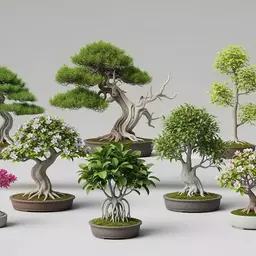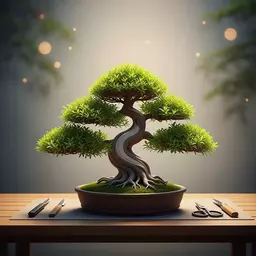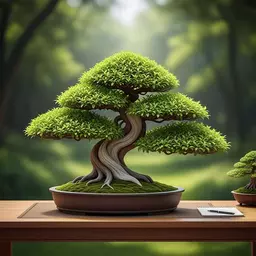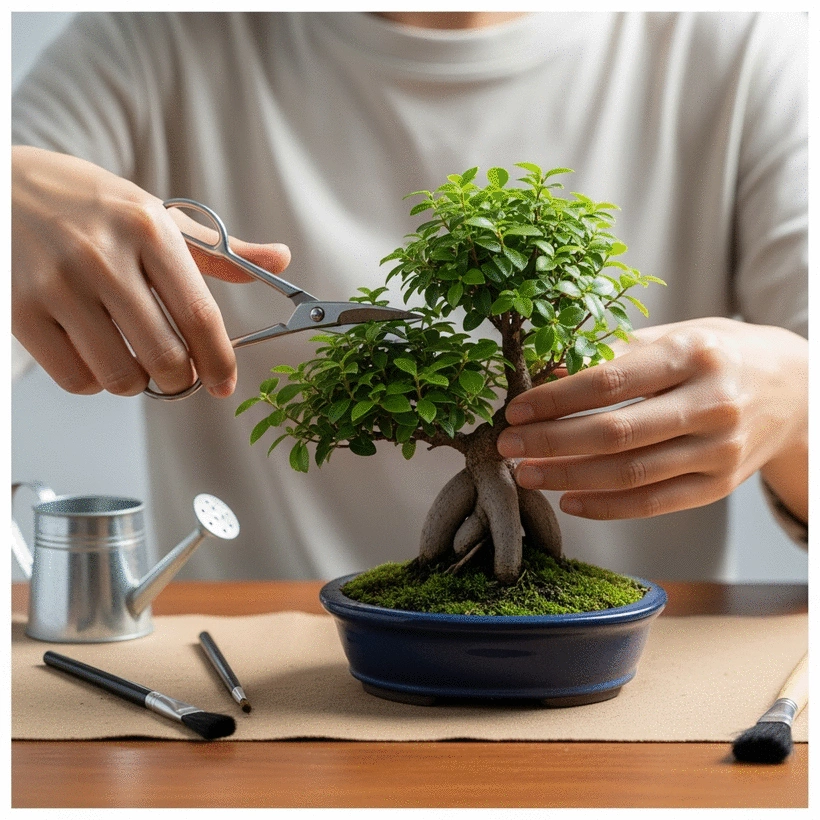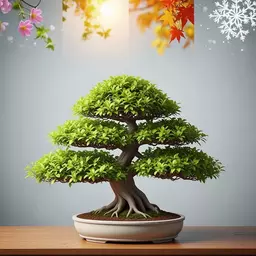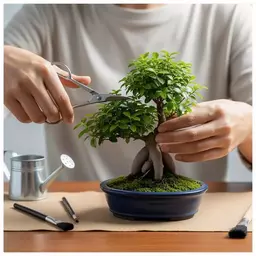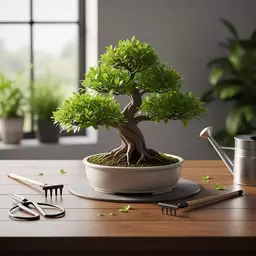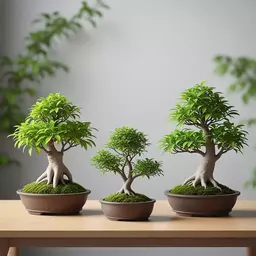Bonsai Care: A Beginner’s Guide
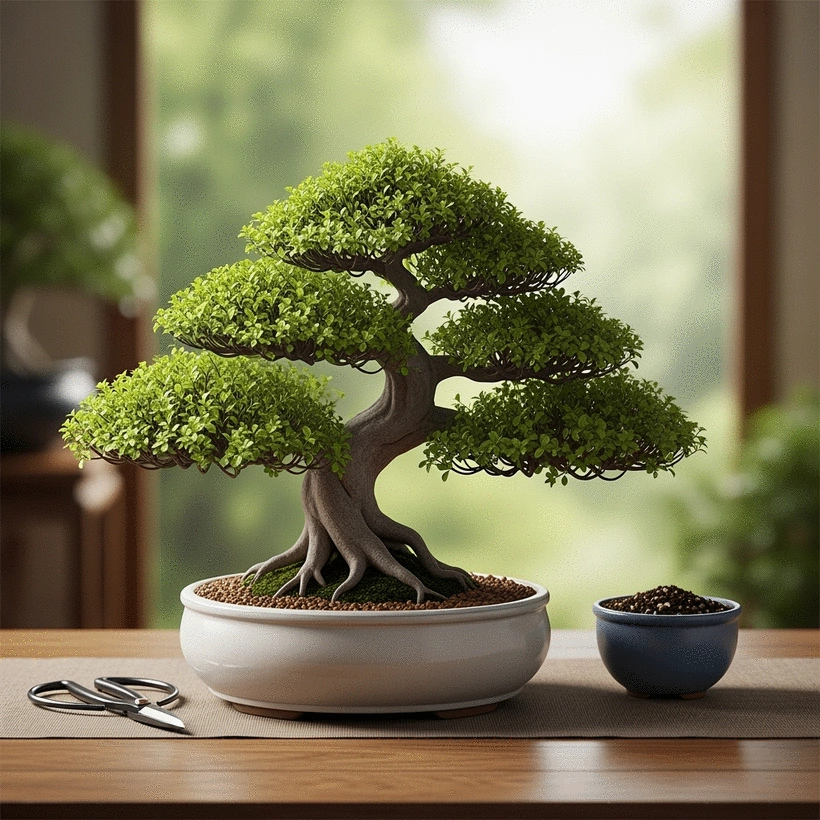
Every care taken in the art of bonsai reflects not just a nurturing spirit, but also a profound connection to nature. As you embark on this journey, consider how each little tree can tell a unique story, shaped by your hands and heart.
What You Will Learn
- Bonsai is not just about growing trees; it's an artistic endeavor that requires styling to reflect your vision.
- Common beginner-friendly bonsai trees include Ficus, Juniper, Chinese Elm, and Pine, each with unique characteristics.
- Three popular bonsai styles to explore are Formal Upright, Informal Upright, and Cascading, each conveying different emotions.
- Establishing a seasonal care routine enhances your bonsai's growth, making each season an opportunity for skill development.
Bonsai Essentials for Beginners
This visual highlights key aspects of starting your bonsai journey: the importance of styling, common beginner-friendly tree types, and popular styling techniques. To learn more about essential tools, check out our guide on Bonsai Basics: Tools and Techniques.
Why Styling is Important
- ✓ Artistic Expression
- ✓ Health & Growth
- ✓ Connection with Nature
Beginner-Friendly Tree Types
- • Ficus (Resilient, Indoor)
- • Juniper (Hardy, Outdoor)
- • Chinese Elm (Adaptable)
- • Pine (Elegant Needles)
Popular Bonsai Styles
- Formal Upright: Straight trunk, symmetrical branches.
- Informal Upright: Gently curving trunk, natural movement.
- Cascading: Flows over pot edge, cliff-like appearance.
Year-Round Care Routine
- ● Spring: Repotting & Pruning
- ● Summer: Regular Watering & Pest Monitoring
- ● Fall: Winter Prep & Disease Check
- ● Winter: Protect from Cold & Reduce Watering
Understanding Bonsai: The Essentials for Beginners
Have you ever felt the soothing calm that comes from nurturing a tiny tree? That’s the magic of bonsai. It’s more than just a hobby; it’s an art form that allows you to connect deeply with nature. In this section, we’ll explore the fundamentals of bonsai, from its definition to why styling matters!
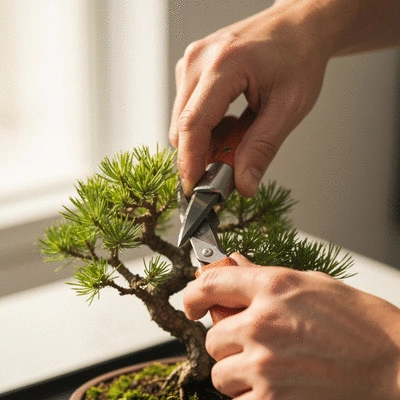
Bonsai is the practice of cultivating miniature trees that mimic the shape and style of full-sized trees. This ancient art emphasizes careful care and styling techniques, transforming a humble plant into a breathtaking piece of living art. As you dive into the world of bonsai, understanding these essentials will help you appreciate the intricate beauty of this craft.
What is Bonsai and Why is Styling Important?
At its core, bonsai is about more than just growing trees; it’s about styling them to reflect your artistic vision. Styling involves shaping the tree through pruning, wiring, and positioning to convey a message or evoke emotion. Each bonsai has its own story, and through styling, you can express your unique journey as a cultivator.
- Artistic Expression: Styling allows you to create a unique form, telling a story through the shape of your bonsai.
- Health and Growth: Proper styling helps your bonsai receive adequate light and air, ensuring vitality and longevity.
- Connection with Nature: Styling fosters a deeper bond with your tree, as each cut and twist is a conversation with nature.
Embracing these principles will not only enhance your bonsai's appearance but also enrich your experience as you nurture it into a masterpiece.
Common Types of Bonsai Trees for Beginners
If you're just starting your bonsai journey, choosing the right tree is crucial. Here are some popular options that are friendly for beginners:
- Ficus: Known for its resilience, the Ficus is a great choice for indoor bonsai.
- Juniper: A classic outdoor bonsai, Junipers are hardy and versatile in styling.
- Chinese Elm: This species adapts well to various conditions and is ideal for new enthusiasts.
- Pine: With its beautiful needles and strong trunk, it adds a touch of elegance to any collection.
Each of these trees offers unique characteristics and challenges, making them perfect for honing your skills as you embark on your bonsai adventure. For more detailed information on specific species, explore our article on Bonsai Trees: 10 Easy Species.
Exploring Popular Bonsai Styles: Formal, Informal, and Cascading
As you delve deeper into bonsai, you’ll discover various styling techniques that can elevate your practice. Three popular styles to consider are:
- Formal Upright: Characterized by a straight trunk and symmetrical branches, this style represents strength and stability.
- Informal Upright: Featuring a gently curving trunk, this style conveys a sense of natural movement and grace.
- Cascading: In this style, the tree appears to flow over the edge of its pot, reminiscent of trees growing on steep cliffs.
Understanding these styles not only enhances your creative expression but also guides you in shaping your bonsai to reflect your artistic vision. As you practice, you'll find joy in selecting the style that resonates with you the most!
Pro Tip
When styling your bonsai, remember that patience is key. Take your time and observe how your tree responds to each cut and bend. Document your process in a journal to track your progress and reflect on your growth as a cultivator!
Recap of Your Bonsai Care Journey
As we reflect on your journey through the world of bonsai, it's essential to recognize the progress you've made! It's a delicate art that requires patience, but with each step, you're creating a living masterpiece. At Shire Bonsai, we believe that understanding the essentials, seasonal care, and styling techniques will help you cultivate your bonsai into a stunning work of art.
To truly embrace the art of bonsai, consider integrating these key practices into a year-round routine. Think of each season as an opportunity to enhance your skills and deepen your bond with your plant. This way, you’re not just caring for a tree; you’re nurturing a relationship.
Bringing it All Together: A Year-Round Routine
Creating a consistent bonsai care routine can truly elevate your experience. Here's a suggested framework to help you stay organized:
- Spring: Focus on repotting and pruning to encourage new growth.
- Summer: Water regularly and monitor for pests as your bonsai thrives in the warm months.
- Fall: Begin preparing your bonsai for winter; adjust watering schedules and check for any signs of disease.
- Winter: Protect your bonsai from extreme cold; reduce watering and limit exposure to harsh conditions.
By following this simple schedule, you can ensure that your bonsai remains healthy and vibrant throughout the year! Remember, each season brings unique challenges and opportunities for growth. For more specific guidance tailored to your region, consult our Bonsai Care Guide for Australians.
Encouragement for Your Bonsai Growing Experience
Embarking on your bonsai journey can sometimes feel overwhelming, but I want to remind you to enjoy the process! Every snip of the shears and adjustment of the wire is a step towards creating something beautiful. Celebrate your successes, learn from your mistakes, and keep experimenting. Bonsai cultivation is not just about the destination; it's about the joy of nurturing a plant and expressing your creativity.
At Shire Bonsai, we’re here to support you every step of the way. Whether you’re troubleshooting a challenge or seeking inspiration for your next styling technique, know that you're not alone in this journey!
Engaging Further with Bonsai Care
As you continue to cultivate your bonsai, there are plenty of resources to deepen your knowledge and connect with fellow enthusiasts. Engaging with the bonsai community can provide you valuable insights, tips, and encouragement on your growing journey.
Where to Find Additional Resources and Community Support
Online platforms and local bonsai clubs are fantastic places to find additional resources. Here are a few places to consider:
- Websites: Shire Bonsai offers a wealth of articles and guides.
- Social Media: Join bonsai groups on platforms like Facebook or Instagram for tips and inspiration.
- Local Clubs: Look for bonsai societies in your area for hands-on workshops and events.
Connecting with others who share your passion can be a rewarding experience. You'll learn new techniques, share your triumphs, and perhaps even form lasting friendships!
Tips for Continuous Learning and Improvement in Bonsai Styling
Continuous learning is key to mastering bonsai. Consider these strategies to enhance your skills:
- Read: Dive into books and articles about advanced techniques.
- Watch: Explore video tutorials that demonstrate specific methods.
- Practice: Dedicate time to experiment with different styling techniques.

Every bit of knowledge you gain contributes to your confidence and ability as a bonsai artist. Remember, practice makes perfect!
Exploring Bonsai Workshops and Online Tutorials
Participating in workshops can significantly elevate your bonsai skills. Look for local gardening centers or online platforms that offer tutorials. Workshops provide hands-on experience, and you'll get to learn directly from experts. At Shire Bonsai, we are excited to host online tutorials that cater to all skill levels, so stay tuned for announcements!
Connecting with Bonsai Communities and Associations
Joining bonsai associations can be an enriching experience. These communities often organize events, exhibitions, and competitions. They are not only great for learning but also for showcasing your hard work! Here are a few benefits of connecting with these groups:
- Networking: Meet fellow enthusiasts and share experiences.
- Exhibitions: Gain opportunities to present your bonsai.
- Resource Sharing: Access exclusive content and expert advice.
Remember, the bonsai community is vibrant and welcoming. Engaging with others can make your journey even more fulfilling!
Frequently Asked Questions About Bonsai
- What is bonsai?
- Bonsai is an ancient art form and horticultural practice of cultivating miniature trees that mimic the shape and style of full-sized trees in nature. It involves careful care, styling, and aesthetic considerations.
- Why is styling important in bonsai?
- Styling is crucial for artistic expression, allowing you to shape the tree to convey a message or emotion. It also contributes to the tree's health and growth by ensuring proper light and air circulation, and it deepens your connection with nature.
- What are some beginner-friendly bonsai tree types?
- Popular choices for beginners include Ficus (resilient, indoor), Juniper (hardy, outdoor), Chinese Elm (adaptable), and Pine (elegant needles). These species are generally forgiving and offer a good starting point for new enthusiasts.
- What are the three popular bonsai styles mentioned?
- The three popular styles are Formal Upright (straight trunk, symmetrical branches, representing strength), Informal Upright (gently curving trunk, natural movement), and Cascading (tree appears to flow over the pot's edge, resembling cliff-dwelling trees).
- What is a recommended year-round care routine for bonsai?
- A year-round routine includes repotting and pruning in spring, regular watering and pest monitoring in summer, preparing for winter and checking for diseases in fall, and protecting from cold with reduced watering in winter.
Recap of Key Points
Here is a quick recap of the important points discussed in the article:
- Understanding Bonsai: Bonsai is the art of cultivating miniature trees that reflect the shape and style of full-sized trees, emphasizing careful care and styling.
- Importance of Styling: Proper styling through pruning and wiring not only enhances the artistic expression of your bonsai but also supports its health and growth.
- Beginner-Friendly Trees: Popular bonsai choices for beginners include Ficus, Juniper, Chinese Elm, and Pine, each offering unique characteristics for cultivation.
- Exploring Styles: Familiarize yourself with bonsai styles such as Formal Upright, Informal Upright, and Cascading to express your artistic vision.
- Year-Round Care Routine: Implement a seasonal routine focusing on repotting in spring, pest monitoring in summer, preparation for winter in fall, and protection from cold in winter.
- Community Engagement: Connect with local bonsai clubs and online resources for further learning, support, and inspiration as you develop your bonsai skills.
